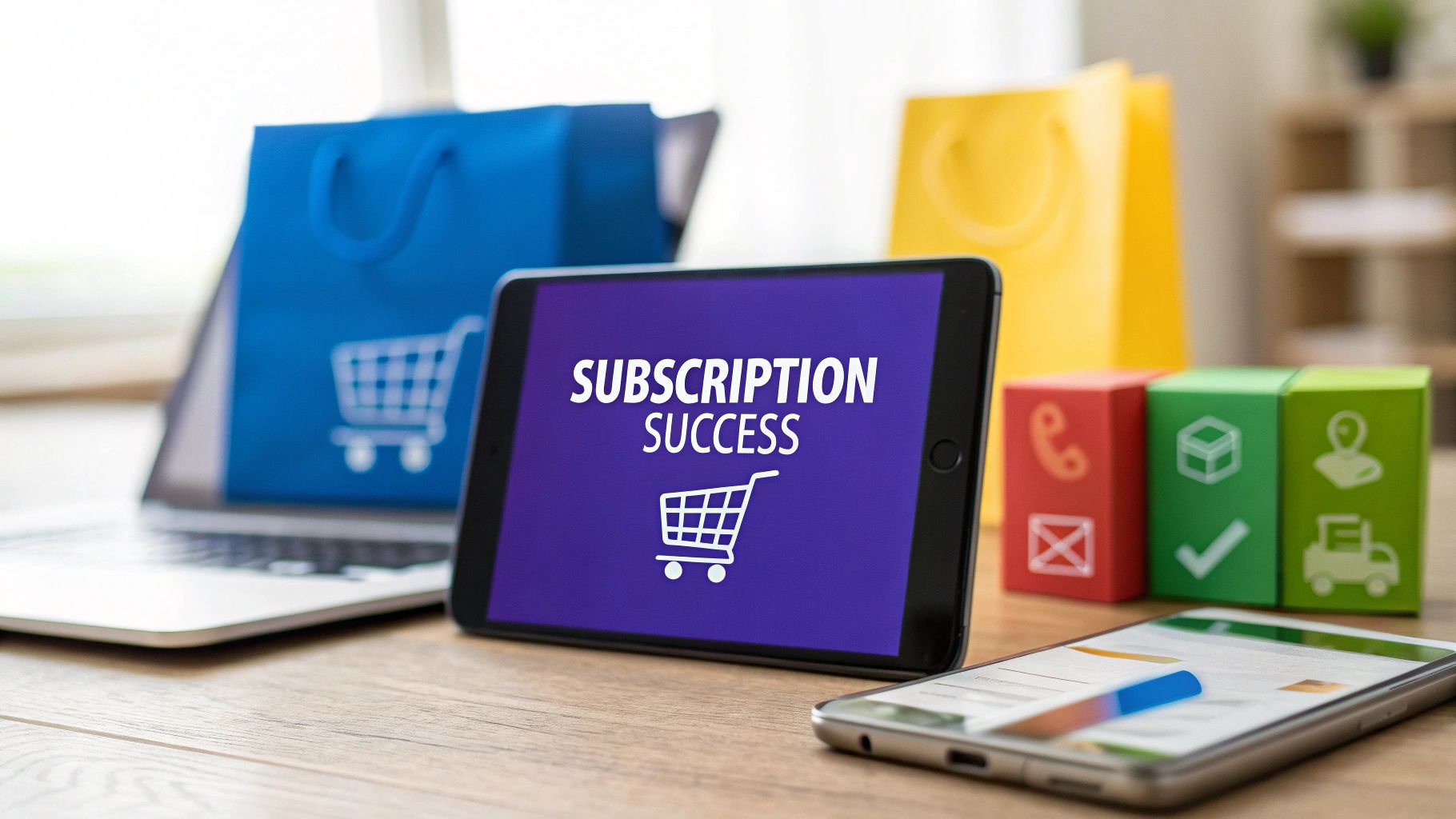The Explosive Rise of Ecommerce Subscription Models
The world of ecommerce is always changing. One of the biggest shifts has been the rise of the ecommerce subscription model. This model, where customers pay a recurring fee, is changing how businesses operate and how people shop. It provides a strong alternative to one-time purchases, creating steady revenue for businesses and offering convenience and value for customers. What's driving this growth?
This shift reflects a change in how consumers shop. The ecommerce subscription model offers many perks for today's shoppers. Automated deliveries save time and effort, eliminating the need to constantly repurchase items. Curated subscription boxes also introduce customers to new products and experiences. This adds an element of surprise and discovery, boosting the appeal of these services.
The market itself is booming. The global subscription e-commerce market hit $278 billion in 2024. Experts predict it will reach a staggering $6,369.9 billion by 2033. This represents a CAGR of 41.38% between 2025 and 2033. This growth is fueled by more and more businesses using subscription models across various industries, from companies like Netflix and Disney+ to beauty, food, and clothing brands. For more detailed statistics, check out this report: Subscription E-Commerce Market
Why Subscriptions Resonate With Consumers
Convenience and novelty aside, psychology plays a role in the success of subscription models. Regular deliveries create a sense of stability and simplify budgeting. This is especially helpful in uncertain economic times. Personalized experiences and exclusive member perks also foster a sense of community, strengthening the bond between brands and customers.
Evolving Beyond the Basics
Early subscription models focused primarily on physical goods, often with a focus on replenishment, like Dollar Shave Club. The model has advanced significantly. Today, diverse subscription types cater to different customer needs.
- Curation Subscriptions: Services like Stitch Fix provide personalized clothing selections in curated boxes.
- Replenishment Subscriptions: These automate essential deliveries, ensuring customers never run out of daily necessities.
- Access Subscriptions: Services like Amazon Prime offer exclusive perks, like free shipping and streaming content.
This wide array of subscription models shows the market's sophistication and ability to adapt to various products and services. This evolution is a key factor in the ongoing growth of the ecommerce subscription model.
Why Businesses Are Flocking to Subscription Commerce

The rise of the ecommerce subscription model is reshaping how businesses operate and earn revenue. It's more than just a passing trend; it's a fundamental shift. This section delves into the compelling advantages driving the widespread adoption of subscription commerce.
The Power of Predictable Revenue
One of the most significant benefits of subscription commerce is predictable revenue. Traditional ecommerce often grapples with fluctuating income due to its reliance on individual purchases. Subscription models, on the other hand, create a recurring revenue stream.
This steady income allows for more accurate financial forecasting and efficient inventory management. Businesses can also invest in future growth with greater confidence. This financial stability is invaluable for businesses of all sizes.
Reduced Customer Acquisition Costs
Acquiring new customers is a costly endeavor. Subscriptions allow businesses to prioritize retaining existing customers over constantly seeking new ones. This significantly reduces customer acquisition costs (CAC), freeing up resources for other critical areas.
These resources can then be reinvested into product development and enhancing customer service, leading to improved product offerings and a stronger customer experience.
Building Brand Loyalty Through Engagement
Subscription commerce nurtures stronger customer relationships. Regular interactions through deliveries, personalized recommendations, and exclusive member benefits foster a sense of community and loyalty.
This approach transforms one-time buyers into dedicated brand advocates. These advocates drive organic growth through word-of-mouth referrals and positive reviews. Subscription commerce also provides valuable data insights into customer preferences. Businesses can then use this data to further personalize the customer experience, boosting satisfaction and retention.
Subscription models offer convenience and personalized experiences, resulting in high conversion rates across various sectors. In 2022, for instance, groceries led the subscription category, with 41% of global subscribers opting for regular food deliveries. For more detailed insights, explore these Subscription Commerce Statistics.
The Psychology of Subscription Stickiness
The success of subscription commerce isn't just about business strategy; it's also about consumer psychology. The convenience of automated deliveries simplifies daily life and budgeting. The element of surprise and delight in curated boxes keeps customers engaged.
These factors contribute to a higher customer lifetime value (CLTV), making the ecommerce subscription model a compelling option for sustainable, long-term business growth.
Winning Ecommerce Subscription Models in Action
What makes some ecommerce subscription models flourish while others falter? The key lies in understanding the fundamental structures shaping today's subscription landscape. Three primary models are reshaping how businesses operate: replenishment, curation, and access.
Each model caters to a specific customer need and employs unique strategies to maximize customer lifetime value.
Replenishment: The Convenience King
The replenishment model simplifies the purchase of everyday essentials. A prime example is Dollar Shave Club, which revolutionized the razor industry by automating blade deliveries. This model focuses on convenience and predictability. Consumers appreciate the ease of not having to remember to reorder necessary items.
Pricing strategies for replenishment models often include discounts for longer subscriptions or bulk purchases. This rewards customer loyalty while securing recurring revenue.
Curation: The Personalization Powerhouse
Curation models, such as Stitch Fix, excel at personalized recommendations. They cater to the desire for discovery and unique experiences. By carefully selecting products based on individual preferences, these services offer a distinct value proposition.
Customer retention in this model depends on consistently delivering high-quality selections and maintaining personalization accuracy. This can be achieved through detailed preference questionnaires and data-driven insights.
Access: Unlocking Exclusive Perks
Access subscriptions, like Amazon Prime, offer a suite of benefits for a recurring fee. These benefits can range from free shipping to streaming services. The key to success here is perceived value. Customers must believe they are receiving significant benefits that justify the ongoing cost.
Some innovative brands combine elements of different models. Imagine a coffee subscription that offers both replenishment (regular bean deliveries) and access (exclusive discounts on brewing equipment). This hybrid approach can strengthen customer engagement and loyalty.
You might be interested in: 10 Subscription Business Model Examples To Boost Growth
Choosing the Right Model for Your Business
The optimal ecommerce subscription model depends on your specific product and target audience. Replenishment works well for consumables. Curation is suited for products with a strong element of personal preference. Access models are ideal for services or bundled benefits.
Understanding the nuances of each model is essential for building a sustainable and successful subscription business. Key factors to consider include customer acquisition cost, average retention rate, and the most suitable product categories for each model.
To help illustrate these differences, let's look at a comparison table:
Comparison of Ecommerce Subscription Model Types
This table compares the three main subscription models across key metrics including customer acquisition costs, retention rates, and best-suited product categories.
| Subscription Type | Key Benefits | Ideal Products | Average Retention Rate | Customer Acquisition Cost |
|---|---|---|---|---|
| Replenishment | Convenience, Automated Ordering | Consumables (Razors, Vitamins) | High (70-90%) | Low-Medium |
| Curation | Personalized Selection, Discovery | Apparel, Beauty Products, Food Boxes | Medium (50-70%) | Medium-High |
| Access | Exclusive Perks, Bundled Value | Streaming Services, Memberships | Medium-High (60-80%) | Medium |
Note: These are estimated ranges and can vary depending on the specific business and industry.
As shown in the table, each model has its strengths and weaknesses. Replenishment excels in retention due to its automated nature. Curation can command a premium price thanks to personalization, but faces the challenge of maintaining novelty. Access models depend on providing a compelling value proposition to justify the ongoing subscription fee. By carefully considering these factors, businesses can choose the model best aligned with their goals and target market.
Crafting Your Subscription Strategy That Actually Works

Launching a successful ecommerce subscription model takes more than just adding a "subscribe" button. It requires a well-defined strategy that connects with your audience and builds lasting loyalty. This involves choosing the right products, creating attractive pricing, and crafting a message that turns casual shoppers into dedicated subscribers.
Identifying Subscription-Friendly Products
Some products are better suited for subscriptions than others. Consumables, such as coffee or pet food, are a natural fit for recurring deliveries because people use them regularly. But even non-consumables can work well if they offer ongoing value. Think of a clothing subscription service offering seasonal updates or style advice. The key is providing convenience and value you can't get with a one-time purchase. This could include subscriber-only discounts, early access to new products, or personalized experiences.
Building Tiered Subscription Offerings
Different subscription tiers allow you to reach customers with different budgets and needs. A basic tier might offer essential products at a lower price. A premium tier could add perks like free shipping, exclusive content, or personalized consultations. A beauty box subscription, for example, might have a basic tier with sample sizes and a premium tier with full-size products and extra gifts. This tiered approach increases customer lifetime value by creating upselling opportunities.
Crafting Compelling Subscription Messaging
To get people past their hesitation about subscriptions, you need to address their concerns. Highlight the ease of automated deliveries, the flexibility of options (like easy cancellation), and the special benefits of subscribing. Offering a risk-free trial is a great way to let people try it out. Testimonials from happy subscribers can also build trust and boost sign-ups.
Optimizing the Onboarding Experience
A positive first impression is key for keeping subscribers. A smooth onboarding process builds a good foundation for the future. This means clear communication about benefits, easy account setup, and personalized recommendations. A welcome email series can introduce new subscribers to the features and perks of their subscription.
For more in-depth information on managing subscriptions effectively, check out our guide on ecommerce subscription management tactics.
Finding the Right Shipping Frequency
How often you ship depends on your product and your customers. Monthly deliveries might be perfect for consumables. For other products, quarterly or twice a year could be better. Giving customers control over their shipping frequency increases satisfaction and reduces cancellations. This can also tie into your tiered offerings, with higher tiers getting more frequent deliveries.
Building a Sustainable Subscription Business
Long-term success means balancing immediate profits with keeping customers happy. Discounts can attract new subscribers, but relying too much on them can hurt your bottom line. Focus on the unique value you offer and create a community around your brand. This builds loyalty and keeps people subscribed even without constant discounts. This approach creates a solid base for sustainable growth.
The following table provides a roadmap for building a successful subscription service:
Ecommerce Subscription Model Implementation Roadmap
A step-by-step guide showing the key milestones in launching a subscription service from concept to scaling
| Implementation Phase | Key Activities | Timeline | Success Metrics | Common Challenges |
|---|---|---|---|---|
| Concept & Planning | Market research, product selection, pricing strategy | 1-2 Months | Customer interest, projected revenue | Identifying the right product-market fit |
| Development & Setup | Platform integration, payment processing, subscription management system setup | 2-3 Months | Integration completion, system functionality testing | Technical difficulties, integration compatibility |
| Launch & Promotion | Marketing campaigns, initial subscriber acquisition | 1-2 Months | Subscriber acquisition cost, conversion rate | Reaching target audience, managing initial demand |
| Growth & Optimization | Customer retention strategies, upselling/cross-selling, feedback analysis | Ongoing | Churn rate, customer lifetime value | Maintaining subscriber engagement, adapting to changing customer needs |
| Scaling & Expansion | New product offerings, expanding into new markets | Ongoing | Market share growth, revenue growth | Logistical challenges, maintaining quality at scale |
This roadmap outlines the key phases and activities involved in launching and scaling an ecommerce subscription model. By focusing on key metrics and addressing potential challenges, businesses can build a successful and sustainable subscription offering.
The Future of Ecommerce Subscription Models
The ecommerce subscription model is constantly changing, influenced by evolving consumer preferences and new technologies. This creates exciting opportunities, but also poses challenges for businesses looking to build reliable, recurring revenue. Understanding these key trends is essential for creating a successful and sustainable subscription business.
AI-Powered Personalization
One of the biggest changes is the growing use of Artificial Intelligence (AI). AI algorithms analyze customer data like purchase history, browsing habits, and even social media activity to create highly personalized experiences. Imagine a clothing subscription service using AI to predict your favorite styles and sizes, sending you items you're more likely to keep. This personalization boosts customer satisfaction, reduces cancellations, and builds stronger brand loyalty.
Community-Focused Models
Subscription models are now going beyond simply delivering products and are building thriving online communities. These communities offer a sense of belonging and shared interest, increasing customer engagement and loyalty. This might involve exclusive online forums, dedicated social media groups, or even in-person events for subscribers. Community feedback also provides valuable insights for product development and improving the subscription experience.
The Rise of Sustainability
Consumers are increasingly aware of environmental issues, and sustainability is a major focus. Subscription businesses are incorporating sustainable practices, like eco-friendly packaging, carbon-neutral shipping, or partnering with ethical and sustainable suppliers. These initiatives attract environmentally conscious consumers and enhance the value of the subscription.
Market Growth and Trends
The ecommerce subscription market is expected to continue growing, with projections estimating a market size of nearly $3,485.51 billion by 2029, growing at a CAGR of 59.5%. This growth is driven by trends like specialized subscription boxes, rental models, and AI integration for better customer experiences. Find more detailed statistics here
The Influence of Younger Consumers
Millennials and Gen Z are significantly changing subscription expectations. They prioritize experiences and community, valuing enjoyment and connection over traditional benefits. This has fueled the growth of subscriptions centered around entertainment, hobbies, and personal development. Understanding their values and creating subscriptions that fit their lifestyles is key to engaging these younger demographics.
Traditional Retailers Embracing Subscriptions
Traditional retailers are quickly adding subscription options to their businesses. Recognizing the value of recurring revenue, they now offer subscriptions for various products, from groceries to beauty items. This lets them compete with direct-to-consumer subscription brands and build stronger customer relationships. This blend of traditional retail and ecommerce subscription models emphasizes the increasing importance of recurring revenue strategies.
By understanding and adapting to these evolving trends, businesses can prepare their ecommerce subscription models for long-term success in this competitive market. Flexibility and a customer-centric approach are crucial for thriving in the future of subscription commerce.
Conquering the Biggest Subscription Challenges

Even with a fantastic product and a well-defined strategy, subscription businesses in ecommerce face unavoidable hurdles. Tackling these challenges head-on is essential for a consistent recurring revenue stream. This means understanding the common obstacles, implementing proactive measures, and continuously adapting to the changing needs of your subscribers.
Combating Subscription Fatigue
One major obstacle is subscription fatigue. Customers can become overwhelmed with numerous subscriptions or simply lose interest over time. To counteract this, businesses must consistently provide demonstrable value.
This might involve offering exclusive perks, regularly updating product selections, or tailoring the subscription experience to individual needs. Imagine a meal kit service introducing new seasonal menus or a beauty box offering personalized product options. These are excellent ways to re-engage subscribers and remind them of the initial appeal.
Reducing Passive Churn
Passive churn, often stemming from failed payments, is another significant challenge. This happens when a subscriber's payment information expires or is declined, unintentionally ending their subscription. Minimizing passive churn relies heavily on proactive communication.
Automated reminders for expiring payment methods, diverse payment options, and user-friendly account management tools can dramatically reduce these involuntary cancellations. A simple email notification a week before a card expires, for example, can prompt subscribers to update their information, ensuring uninterrupted service.
You might be interested in: 10 Ecommerce Customer Retention Strategies To Boost Sales
Reactivating Dormant Subscribers
Inactive subscribers aren't lost causes; they represent a valuable opportunity for reactivation. Targeted email campaigns offering incentives or showcasing new features can re-engage these dormant users.
A win-back strategy could involve a discount on their next order or a complimentary gift with their renewal. These gestures demonstrate that you value their business and encourage them to re-subscribe.
Creating Flexibility and Adaptability
Customer needs evolve, so your subscription model should too. Offering multiple subscription tiers, flexible delivery schedules, and easy pause/cancellation options empowers subscribers and gives them more control.
This could include allowing subscribers to skip a month's delivery or change their product preferences. Such flexibility fosters trust and reduces cancellations due to life changes.
Monitoring Key Metrics for Early Warning Signs
Tracking essential metrics like churn rate, customer lifetime value (CLTV), and customer acquisition cost (CAC) provides invaluable insights into the health of your subscription business. A rising churn rate, for example, could signal problems with product quality or customer service.
Regular monitoring allows for early identification of issues and timely corrective action. A sudden spike in negative reviews, for instance, could indicate a need to address product or shipping concerns.
Navigating the Regulatory Landscape
Subscription businesses must adhere to all applicable regulations concerning cancellation policies, renewal notifications, and other legal requirements. Staying informed and compliant is crucial for avoiding legal problems and maintaining customer trust.
This could involve clearly displaying cancellation terms on your website or providing advance notice of renewals. Transparency in these areas fosters confidence and strengthens customer relationships.
Building a Successful and Sustainable Subscription Model
By proactively addressing these challenges, businesses can build a loyal subscriber base, minimize churn, and maximize the long-term value of their subscriptions. This requires ongoing improvement, a commitment to customer satisfaction, and the ability to adapt to the dynamic subscription landscape.
Ready to elevate your Shopify store with subscriptions, courses, and community features? Explore how Tevello can seamlessly integrate these powerful tools into your existing platform, helping you create a thriving online business.





